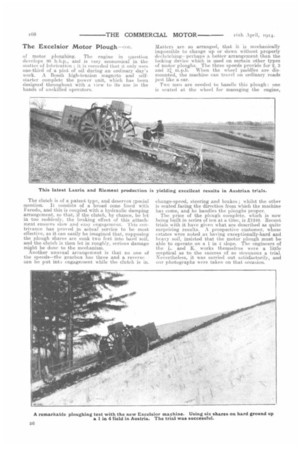The Excelsior Motor Plough.
Page 19

Page 20

If you've noticed an error in this article please click here to report it so we can fix it.
A Sell-contained Machine and the Remarkable Work it is Accomplishing.
Although, up to the present, the farmers in this country have not evinced much practical interest in the possibilities of the cultivation of the land by means of motor-driven ploughs and other implements, quite a number of English manufacturers are bent upon developing this class of plant to the best of their ability. On the Continent, agriculturists are taking more active interest in the -subject, and it behoves us to watch with care the developments that are consistently taking place, in France and Germany particularly, in connection with the design, construction and employment of the agrimotor as a class.
We have pleasure in giving .particulars of a new type of motor plough, which has been produced in the well-known works of Laurin and Klement, Ltd., of Jungbun.zfau, Bohemia, Austria, in conjunction with a local factory of agricultural machinery, owned by Messrs. Beecher and Co., of the same town, Many -of our readers will remember the publicity which we gave recently to particulars of the construction of the Stock motor plough and of its appearance in this country. In general appearance this new Excelsior construction is atfirst sight very similar. But, as a matter of fact, the likeness is limited to the outline appearance. In general type. the new machine, as is shown by our photographs, has has its engine mounted on the front of a long frame, which is carried on two large diameter driving wheels. Attached to the end of this balanced frame is the plough frame proper, with its six shares, the rear mounted on a special guide wheel. Continental agriculturists, who are giving the question of mechanical land cultivation their careful attention, are coming to the conclusion that the most suitable plant will develop along two definite lines. One of thee has been recently illustrated clearly by the fine collection of small self-contained, two-share ploughs and hoes which were shown at Paris. The
other branch of development appears to be on the lines of the Stock and the Excelsior, The chassis construction and the engine of the Excelsior follow, so far as possible, modern car practice in respect of assembly and construction. The engine has four cylinders cast in two pairs, with all the exposed parts carefully encased, in order to obviate trouble from the effects of dust, which, of course, is very freely thrown up during the operation
of motor ploughing. The engine in question develops 80 b.h.p., and is very economical in the matter of lubrication ; it is recorded that itonly uses one-third of a pint of oil during an ordinary day's work. A Bosch high-tension magn3to and self-. starter complete the power unit., which has been designed throughout with a view to its use in the hands of unskilled operators.
The clutch is of a patent type, and deserves special mention. It consists of a broad cone lined with Ferodo, and this is coupled with a hydraulic damping arrangement, so that, if the clutch, by chance, be let in too suddenly, the braking effect of this attachment ensures slow and easy engagement. 'Ibis contrivance has proved in actual service to be most effective, as it can easily be imagined that, supposing the plough shares are sunk two feet into hard soil, and the clutch is then let in roughly, serious damage might be done to the mechanism.
Another unusual arrangement is that no One of the speeds—the. 'gearbox has three and a reversecan be put into engagement while the clutch is in. Matters are so arranged, that it is mechanically impossible to change up or down without properly declutehing--perhaps a better arrangement than the locking device which is used on certain other types of motor ploughs. The three speeds provide for 2, 3 and 31. m.p.h. When the wheel paddles are dismounted, the machine can -travel en ordinary roads just like a car.
Two men are needed to handle this plough: one is seated at the wheel for managing the engine, change-speed, steering and brakes ; whilst the other is seated facing the direction from which the machine has come, and he handles the ploughs proper.
The price of the plough c4nnpIete, which is now being built in series of ten at a time, is 21240. Recent trials with it have given what are described as quite surprising results. A prospective customer, whose estates were noted as having exceptionally-hard and heavy soil, insisted that the motor plough must be able to operate on a 1 in 4 slope. The engineers of the L. and K. works themselves were a little sceptical as to the success of so strenuous a trial. Nevertheless, it was carried out. satisfactorily, and our photographs were taken on that occasion.
























